A root-bound plant is one where the roots have become so tightly compacted that they’re unable to take in adequate amounts of water or nutrients. This can happen for a number of reasons but is often the result of being grown in a pot that’s too small.
If you’re the parent of a pothos plant that you’ve noticed has been looking a bit sad, you may be wondering if your pothos is root-bound and what, if anything, you can do about it.
I’ll break down everything you need to know about root-bound pothos plants, including how to tell if your plant is root-bound and what to do about it. By the end of this post, you’ll be an expert on root-bound pothos plants and keep your plant’s roots happy at all times!
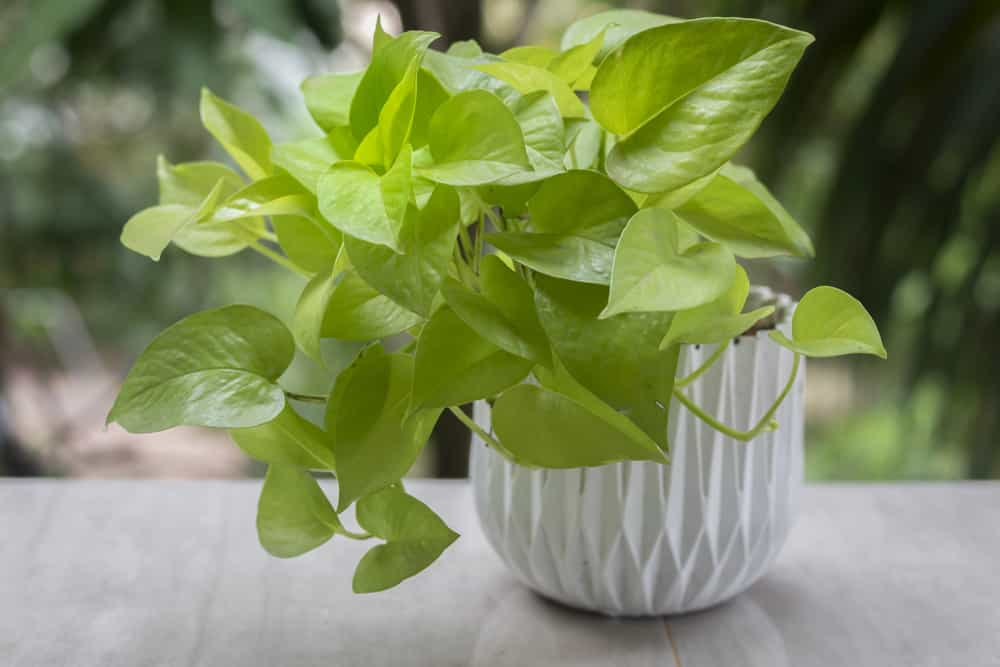
Table of Contents
Do pothos plants like to be root bound?
No, your pothos doesn’t enjoy being root bound. This plant needs room to grow, so being pot-bound puts stress on the plant. Your pothos will give you clues that it’s not happy. For example, the leaves may yellow and the stems will become leggy as the plant stretches to reach for the light.
A pothos which is root bound will have roots that have become matted and tangled. This mass of roots prevents the plant from taking in adequate amounts of water and nutrients, which can lead to problems. The main issue associated with root-bound plants is slow growth, but it can lead to more serious issues.
Find out more: How Fast Does Pothos Grow (and How to Make it Grow Faster)?
Other plants, such as cactus or succulents, don’t mind being root bound. In fact, some plants need to be pot-bound in order to thrive. This is because they come from arid regions and don’t need a lot of water or soil.
The best way to fix a root-bound pothos plant is by preventing it from happening in the first place. With proper maintenance and care, you can make sure that your pothos plant’s roots have the space they need to grow.
Did you know: Certain plants are more likely to become root bound than others. For example, fast-growing plants or those that have a tendency to produce a lot of roots are more likely to become root bound. Pothos falls into both of these categories.
Can pothos survive being root bound?
A pothos may be able to survive being root bound, depending on how severe the problem is. If the roots are only slightly tangled, the plant may be able to continue growing without any problems. However, if the roots are severely matted and compacted, the plant may not be able to take in adequate amounts of water or nutrients.
The length of time that you leave your pothos plant root-bound will also play a role in its survival. If you wait too long to repot the plant, it may not be able to recover. Too long can mean anywhere from a few months to a year, depending on the size of the pot it’s in and the plant’s age.
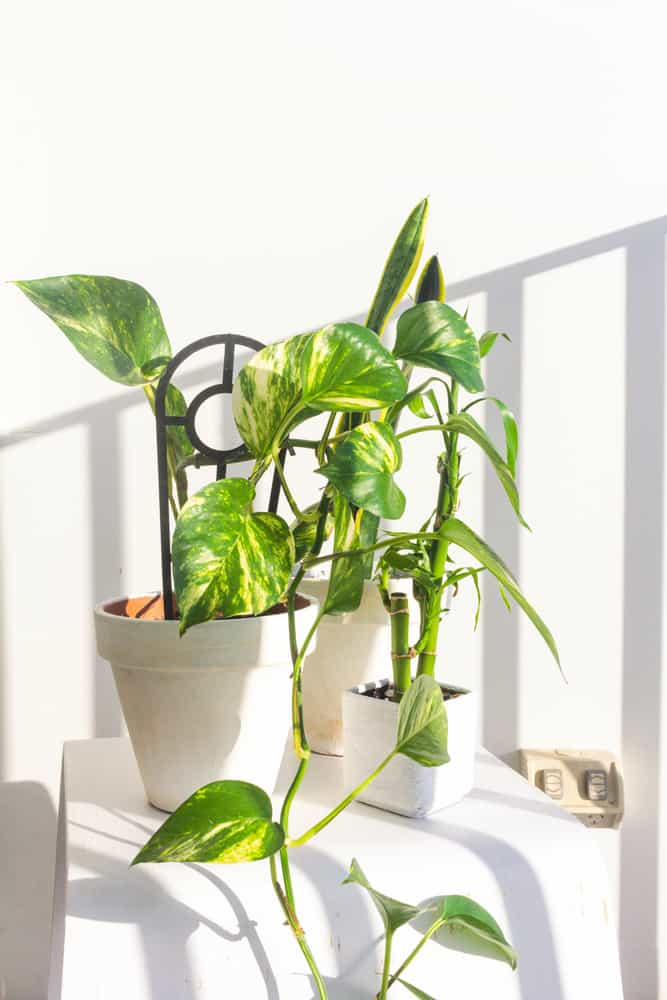
Sometimes a root-bound plant will survive for a longer time if it’s older. This is because the plant has a larger root system and can tolerate being pot-bound for longer. However, if the plant is young, it may not be able to survive being root bound as long.
The bottom line is that you should repot your pothos plant as soon as you notice that it’s root bound. The sooner you act, the better chance your plant has of surviving. Regular maintenance is key to keeping your pothos plant healthy and happy.
How can you tell if a pothos is rootbound?
When your pothos plant is root-bound, you’ll see it start to suffer from a slow growth rate, increasingly visible roots, and the leaves won’t appear as full and healthy as they should. Try to lift the plant out of the pot and get a good look at the roots in order to determine if it’s root-bound.
Here is a list of the main signs of a root-bound pothos plant:
1. Slow growth rate
If you don’t see the roots themselves, you may still be able to tell that your pothos plant is root-bound by its growth rate. A healthy plant will grow at a steady rate, while a root-bound plant will grow more slowly.
You can compare the growth rate of your pothos plant to other plants in order to get an idea of how fast it should be growing. You can also take note if your pothos is growing slower than it did previously. If you notice that your plant is growing more slowly than others, it’s likely root-bound.
2. More visible roots
The most obvious sign of a root-bound pothos plant is more visible roots. This means that the roots may be visible when you look into the soil, or they may be growing out of the drainage holes in the bottom of the pot.
If you see roots coming out of the bottom of the pot, it’s definitely time to repot your plant. Allowing the roots to continue growing like this will only make the problem worse and could eventually kill your plant.
3. Leaves aren’t as full or healthy looking
Another sign of a root-bound pothos plant is that the leaves won’t look as full or healthy as they should. The leaves may be smaller than normal, or they may have yellow patches or appear light green.
The leaves may also look dried out since root-bound plants don’t do a great job of absorbing water, which is why this is often the cause of your pothos’ leaves curling. With severely root-bound plants, the leaves may even drop off of the plant.

4. Stems are leggy
Legginess happens when the stems of the plant are longer than they should be. This is usually a result of the plant not getting enough light. However, it can also be a sign of a root-bound plant.
If you notice that your pothos plant has leggy stems, take a look at the roots to see if they’re tangled and compacted. If they are, it’s likely that the plant is root-bound and not getting enough nutrients, and searching for more from the sun.
5. Cracks in the pot
If you notice that the pot your pothos plant is in has cracks, it’s a good indication that the plant has outgrown it. As the roots grow, they can push against the sides of the pot and cause it to crack.
This is especially true for clay pots which are more fragile than other types of pots. If you see cracks in the pot, it’s time to repot your pothos plant into a larger size.
6. Overly dry soil
When a plant is root-bound, it can displace the soil in the pot over time. So, if you notice that the soil in your pot is dry, it may be a sign that the plant is root-bound.
The soil in the pot may also lose its nutrients over time, which can cause the plant to suffer. If you notice that the soil is dry or doesn’t have many nutrients, it’s a good idea to repot your plant (ideally using one of the top picks for the best soil for pothos plants).
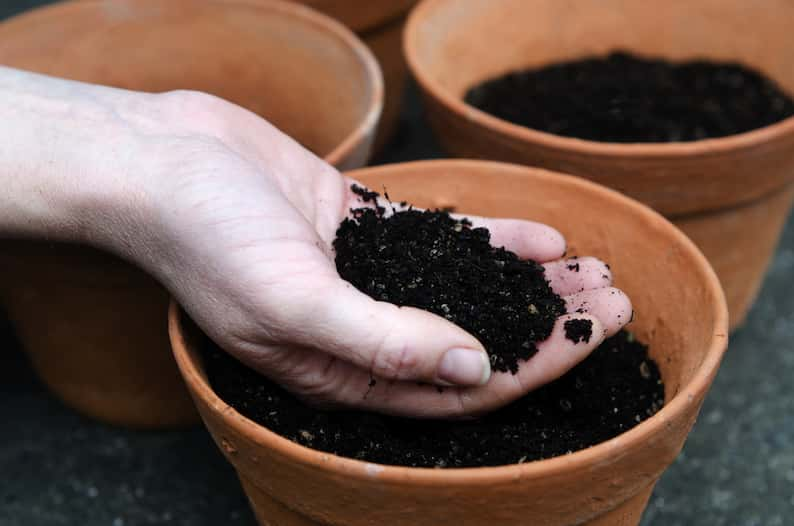
7. Spiraled roots at the bottom of the pot
When you take your pothos plant out of the pot, you may notice that the roots are spiraled at the bottom. This is a sure sign that the plant is root-bound and needs to be repotted. Allowing the roots to continue growing like this will only make the problem worse and could eventually kill your plant.
Be very careful when you remove the plant from the pot, as the roots can be very fragile. Try to avoid breaking them if possible, as this isn’t good for the plant.
How do you fix a pothos that’s root bound?
The best way to fix a pothos that is root bound is by repotting it into a larger container. It needs to be placed into a pot that is about 2 to 3 inches larger than the previous pot. Be sure to use fresh potting soil when replanting, and water the plant well.
It’s a good idea to repot your pothos plant every 2 or 3 years, even if it doesn’t seem root-bound. This will help to keep the plant healthy and prevent it from becoming root-bound in the future.
Best soil for Pothos
Miracle-Gro Tropical Potting Mix
Light and well-draining (perfect for avoiding root rot) while being packed with just the right nutrients – that will feed your plant for up to six months. The best soil for keeping your pothos healthy and strong.
When you replant your pothos plant, you’ll notice that it looks much healthier and is growing more vigorously. The leaves will be a deeper green, and the pothos will have a fuller appearance. Repotting is a great way to revive a pothos plant that isn’t doing well.
This recovery will take some time, so be patient and don’t expect results overnight. You will want to supplement it with some liquid fertilizer during this time to help the plant recover from being root-bound. After a few weeks, you should see new growth on your pothos plant.
How do you repot a root bound pothos?
You repot a pothos by gently transferring it into a larger pot so that the roots have more room to grow. Transferring your plant can be a form of shock, so you will want to make sure you do it correctly and with great care.
Here is a step-by-step guide to repotting your pothos plant:
1. Gather your supplies
To start, you will need to gather a new pot, some fresh potting soil, and some water. The new pot should be about two to three inches larger than the previous pot. Once you have everything gathered, it’s time to get started.
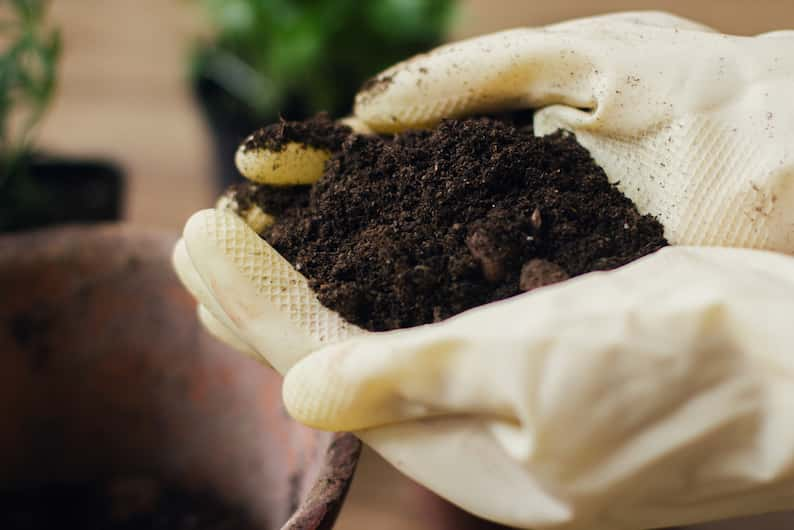
2. Remove the plant
Start by gently removing your plant from the pot. Be very careful not to damage the roots. Once the plant is out of the pot, take a look at the roots. If they’re tangled or compacted, it’s likely that your plant is root-bound.
Gently dust off the soil on them to get a clear look. Check for other issues such as root rot on your pothos while you have a clear view of the roots. If the plant doesn’t seem too root-bound, you can skip to step four. Otherwise, continue to the next step.
3. Loosen the roots
If the roots are tangled or compacted, you will need to loosen them up before replanting. You can do this by gently massaging the roots with your fingers. Be careful not to damage them.
This helps to encourage new growth and allows the roots to spread out more easily. It will help to break the pattern of spiraling roots, where the roots grow in a tight coil.
4. Prepare your pot with fresh soil
Once you have loosened the roots, it’s time to prepare your pot with fresh soil. Be sure to add enough soil so that the plant will be stable in the pot. You don’t want the roots to be exposed.
Pothos plants like soil that is moist but not soggy, so be sure to lightly water the soil before replanting. You can use a multi-purpose potting mix or make your own by mixing equal parts peat moss and perlite.

5. Put your Pothos in the new pot
Fill the pot about halfway with soil, then place your plant on top. You may need to add more soil to cover the roots completely. Be sure not to pack the soil too tightly, as this can stunt root growth.
Fill the pot the rest of the way with soil and gently water it. Don’t pack down the soil too much, as this can cause problems with drainage. Your pothos needs drainage to survive, so this could lead to even bigger problems in the end.
6. Keep an eye on your plant
Once you have replanted your pothos, it’s important to keep an eye on it. The first few days after replanting can be stressful for your plant, so be sure to give it some extra TLC.
Should you break up roots when repotting pothos?
Breaking up the roots can help to encourage new growth, but you should be careful not to damage them. If the roots are tangled or compacted, you can try loosening them up with your fingers before replanting. Be as gentle as possible to avoid damaging the roots.
Make sure to use clean, sharp shears to avoid damaging the plant. Cut away any dead or damaged roots, and trim back any long roots so they’re about two inches shorter than the pot.
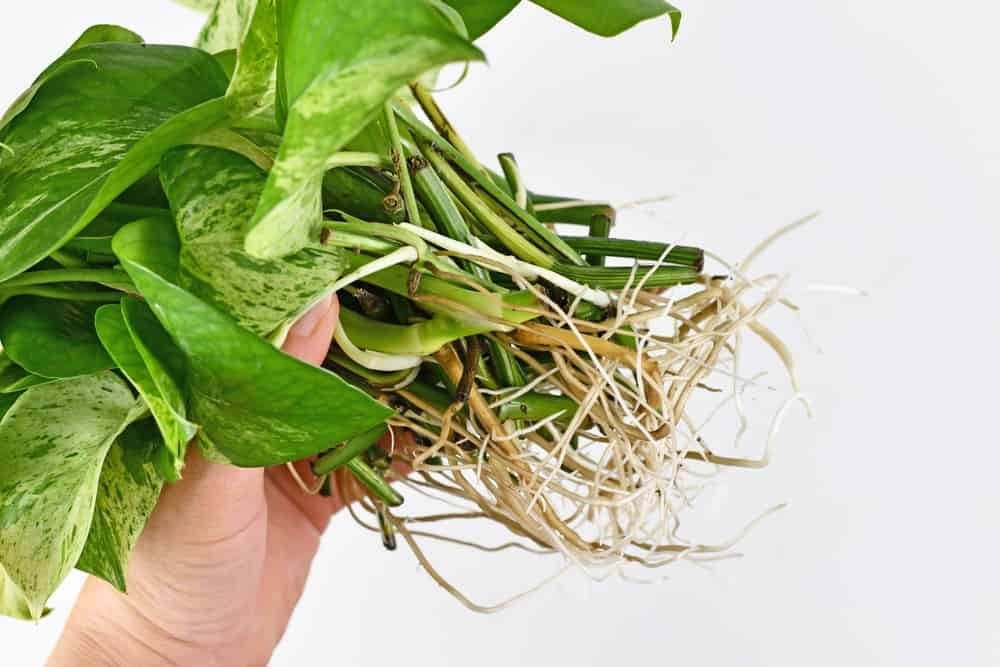
Never remove more than one-third of the roots when repotting. This could shock your plant and damage it beyond repair.
Breaking up roots is healthy for your pothos plant because it encourages new growth. This will lead to a plant that grows quickly, produces lush green leaves, and is bushy.
Don’t break up the roots of your pothos plant if they’re healthy and not compacted. If the roots are healthy, there’s no need to break them up. This will cause unnecessary stress on the plant which may slow its growth and leaf production.
How to divide a rootbound pothos
In order to divide a root-bound pothos plant, gently separate and cut the roots into several different sections. Make sure your cutting device is sterile and sharp to avoid damaging the roots. Once you have divided the plant, pot each section in its own pot filled with fresh soil.
Be sure not to pack the soil too tightly, as this can stunt root growth.
Give each plant some water and keep them in a warm, bright spot. Avoid direct sunlight, favoring diffused bright light. You will see new growth in a few weeks with regular watering.
How to prevent pothos from being root bound?
The best way to prevent your pothos from becoming root-bound is to repot it every one to two years. This gives the roots plenty of room to grow and also allows you to refresh the potting mix. Buy a container that is only two inches larger in diameter than the previous pot and carefully transfer it.
Make sure to use a clean, sharp knife or shears to avoid damaging the roots. Cut away any dead or damaged roots, and trim back any long roots so they’re about two inches shorter than the pot.
Pruning your plants regularly will also help to prevent this from happening. If you prune your pothos slightly but consistently, it won’t be shocked and will recover healthily in no time.
A final option is to divide the plant. When a plant is divided, you can use the roots to create new plants. This is a good option if you want to give your plant away or create more plants for yourself.
Keeping an eye on the above-mentioned factors will help you keep your pothos plant healthy and prevent it from becoming root bound. This includes watching for a slow-growing plant, visible roots, or cracks in the pot. If you see any of these, it’s time to repot your plant!

